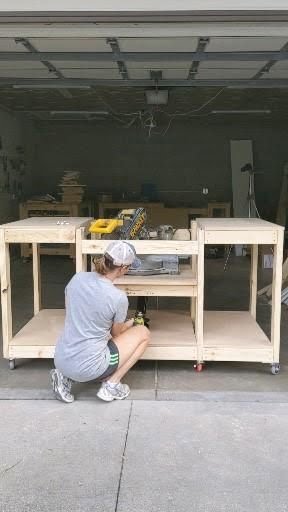Are you a woodworking enthusiast looking for a simple CAD program to enhance your design process? Look no further. In this article, we will explore the world of CAD programs specifically tailored for woodworking projects. Whether you’re a beginner or an experienced woodworker, utilizing a CAD program can bring numerous benefits to your craft.
CAD, or Computer-Aided Design, has become an essential tool in the woodworking industry. It allows woodworkers to create detailed and accurate designs for their projects with ease and precision. By using a simple cad program for woodworking, you can streamline the design process, reduce errors, and visualize your creations before even stepping into the workshop.
In this comprehensive guide, we will take a closer look at why using CAD programs for woodworking is advantageous. We’ll also delve into the key features to consider when choosing a simple CAD program tailored for woodworking projects.
Additionally, we will provide you with valuable tips and tricks on how to maximize the use of these programs and share real-life examples of woodworking projects created using CAD software. Whether you’re new to CAD or looking to upgrade your current software, this article will help you make an informed decision when choosing the right simple CAD program for your woodworking needs.
Understanding the Benefits of Using CAD for Woodworking Projects
Using CAD (Computer-Aided Design) programs for woodworking projects offers numerous advantages to woodworkers of all skill levels. From providing a platform for detailed planning and visual representation to streamlining the design process, CAD programs have revolutionized the way woodworkers approach their projects.
Improved Planning and Visualization
One of the primary benefits of using CAD for woodworking is the ability to plan and visualize projects in a digital space. With the use of 3D modeling, woodworkers can create accurate representations of their designs, allowing them to identify potential issues and make necessary adjustments before beginning the physical construction process. This not only saves time and materials but also ensures that the final product meets the desired specifications.
Precision and Accuracy
CAD programs enable woodworkers to work with precise measurements and dimensions, resulting in greater accuracy in their designs. Whether it’s creating intricate joinery, complex cuts, or detailed carvings, CAD allows for precise execution of woodworking tasks that may be challenging to achieve through traditional methods alone.
Increased Efficiency and Productivity
By utilizing a simple CAD program for woodworking, woodworkers can streamline their design process, leading to increased efficiency and productivity in the workshop. With the ability to experiment with different design options, simulate assembly processes, and generate detailed cut lists, woodworkers can save valuable time while ensuring that their projects are executed with precision. Additionally, by having digital files readily available, mistakes or adjustments can be rectified without needing to start from scratch on a new physical piece.
Features to Look for in a Simple CAD Program for Woodworking
When looking for a simple CAD program for woodworking, it’s important to consider the specific features that will best suit your woodworking needs. Here are some key features to look for in a simple CAD program for woodworking:
- Intuitive User Interface: A user-friendly interface is essential for a simple CAD program, making it easy to navigate and use, even for beginners.
- 2D and 3D Modeling Capabilities: Look for a program that allows you to create both 2D and 3D designs, as this versatility can be incredibly useful for woodworking projects.
- Library of Woodworking Materials and Tools: The ability to access a library of pre-designed woodworking materials, such as different types of wood, fasteners, and tools, can save you time and effort in the design process.
- Precision Drawing Tools: Look for drawing tools that offer precise measurements and angles, allowing you to create accurate designs for your woodworking projects.
In addition to these basic features, it’s also important to consider compatibility with other software or machinery you may be using in your woodworking projects. For example, if you plan on using CNC machines or other automated equipment, ensure that the CAD program is compatible with these systems.
Ultimately, the goal is to find a simple CAD program that offers the right balance of user-friendly features and powerful design capabilities to enhance your woodworking projects. By considering these key features, you can make an informed decision when choosing the best CAD program for your woodworking needs. Finding the right balance between simplicity and functionality will allow you to streamline your workflow and create stunning woodworking designs with ease.
Top 5 Simple CAD Programs for Woodworking
When it comes to woodworking, using a simple CAD program can help streamline the design process and ensure precision in your projects. With so many options available, it can be overwhelming to choose the right CAD program for your woodworking needs. To make the decision easier for you, we’ve compiled a detailed comparison of the top 5 simple CAD programs for woodworking.
SketchUp
SketchUp is a popular choice among woodworkers due to its user-friendly interface and intuitive tools. It allows users to create 3D models with ease, making it ideal for visualizing woodworking designs before starting a project. Additionally, SketchUp offers an extensive library of pre-made models and a supportive community for users to seek help and inspiration.
AutoCAD LT
AutoCAD LT is known for its powerful drafting and detailing tools, making it a great choice for precise woodworking projects. It provides comprehensive drawing capabilities and supports industry-standard file formats, enabling seamless collaboration with other professionals in the field. While it may have a steeper learning curve compared to other programs, its robust features make it worth considering.
Fusion 360
Fusion 360 is a versatile CAD program that offers parametric modeling, simulation, and rendering tools – all essential for woodworking projects. Its cloud-based platform allows for easy access to designs from anywhere, making it convenient for woodworkers who work on multiple devices or collaborate with others remotely.
SolidWorks
SolidWorks is widely recognized for its advanced design capabilities and engineering-focused tools, making it suitable for complex woodworking projects. It offers extensive customization options and automation features that can significantly improve productivity in creating detailed woodworking designs.
FreeCAD
As the name suggests, FreeCAD is an open-source CAD program that is free to use and boasts an active community of developers constantly improving its functionality. While it may not have all the bells and whistles of paid programs, FreeCAD is still a viable option for woodworkers on a budget or those who prefer open-source software.
By taking into account your specific woodworking needs and preferences, you can compare these top 5 simple CAD programs to find the best fit for your next project.
Step-by-Step Guide on How to Use a Simple CAD Program for Woodworking
Using a simple CAD program for woodworking can help you create precise and detailed designs for your projects. Whether you are a beginner or an experienced woodworker, learning how to use these programs can greatly improve the quality and efficiency of your work. Below is a step-by-step guide on how to use a simple CAD program for woodworking:
1. Familiarize Yourself with the Interface: When you first open the CAD program, take some time to explore the different tools and features available. Look for basic functions such as drawing lines, arcs, circles, and rectangles, as well as text and dimensioning tools.
2. Start Your Design: Begin by creating a new project and setting up your workspace. Use the drawing tools to sketch out the basic shape of your woodworking project. You can also use measurement tools to ensure accurate dimensions.
3. Add Details and Precision: Once you have the basic outline of your design, start adding details such as notches, joints, or decorative elements using the editing tools available in the CAD program. Take advantage of snap grids and alignment tools to maintain precision in your design.
4. Review and Edit: After completing your design, review it for any errors or areas that may need adjustment. Make use of editing features such as trim, extend, mirror, or rotate to refine your design.
5. Save and Export: Once you are satisfied with your design, save your work in the appropriate file format supported by the CAD program. You can then export it for further collaboration with other woodworkers or for manufacturing purposes.
By following this step-by-step guide, you can effectively utilize a simple CAD program for woodworking to create detailed and accurate designs for your projects.
Overall, incorporating a simple CAD program into your woodworking process can streamline production and reduce waste from mismeasurements while providing an opportunity to experiment with various designs without utilizing costly materials until finding one suitable for actual construction across all skill levels in woodworking enthusiasts.
Tips and Tricks for Maximizing the Use of a Simple CAD Program for Woodworking
Woodworking projects can greatly benefit from the use of a simple CAD program, but maximizing its use requires some tips and tricks. One useful tip is to take advantage of the 3D modeling capabilities of the software.
This feature allows woodworkers to visualize their projects in a more realistic way, making it easier to detect potential design flaws and make necessary adjustments before starting the actual construction process. Additionally, 3D modeling can also help in creating more detailed and accurate plans for woodworking projects.
Another tip for maximizing the use of a simple CAD program for woodworking is to make use of the measurement and dimensioning tools. These tools allow for precise measurements and accurate dimensions, ensuring that all components of the woodworking project fit together seamlessly. This can lead to a more efficient and error-free construction process, ultimately resulting in a higher quality finished product.
Furthermore, taking the time to familiarize oneself with keyboard shortcuts and other time-saving features of the CAD program can greatly improve productivity. Learning these shortcuts and features can help streamline the design process, saving valuable time and making it easier to create complex designs.
| Tips and Tricks for Maximizing CAD Program Use | Benefits |
|---|---|
| Utilize 3D modeling capabilities | Better visualization and detailed planning |
| Make use of measurement and dimensioning tools | Precise measurements and seamless fitting components |
| Familiarize with keyboard shortcuts | Improved productivity and streamlined design process |
Real-Life Examples of Woodworking Projects Created Using Simple CAD Programs
When it comes to woodworking, using a simple CAD program can make a big difference in the design and execution of your projects. These programs offer a range of benefits that can help you bring your ideas to life in a more efficient and precise way. But what exactly can you create using a simple CAD program for woodworking?
One real-life example of a woodworking project created using a simple CAD program is custom furniture design. Whether you want to build a unique table, chair, or shelving unit, CAD programs allow you to create detailed 3D models of your designs before you even pick up a tool. This not only helps you visualize the final product but also ensures that all measurements and proportions are accurate.
Another example is the creation of intricate wood carvings and engravings. With the right CAD program, you can design elaborate patterns and motifs that can be translated onto wood with incredible precision. This opens up a world of possibilities for creating one-of-a-kind decorative elements for furniture, cabinetry, or even standalone art pieces.
Lastly, simple CAD programs for woodworking can be used to design entire woodworking shop layouts. From workbenches to tool storage to dust collection systems, being able to plan and visualize your workshop in 3D before making any physical changes can save time, money, and resources in the long run.
| Woodworking Projects | Example Uses |
|---|---|
| Custom Furniture Design | Create detailed 3D models for visualization and precise measurements |
| Wood Carvings/Engravings | Design intricate patterns with precision for decorative elements |
| Workshop Layouts | Plan and visualize entire workshop setups before making physical changes |
Final Thoughts
In conclusion, choosing the right simple CAD program for your woodworking needs is essential for maximizing efficiency and productivity in your projects. Whether you are a beginner or an experienced woodworker, utilizing a CAD program can greatly benefit the design and planning stages of your projects. With the right program, you can accurately visualize your creations and streamline the manufacturing process.
When considering which simple CAD program to use for woodworking, it’s important to look for features such as user-friendly interface, 3D modeling capabilities, built-in libraries of woodworking materials and tools, and compatibility with CNC machines. These features will enable you to create precise designs and easily communicate them to others involved in the project.
After thoroughly evaluating different options, you can select a simple CAD program that best suits your specific woodworking needs and budget. Remember that investing time in learning how to use the software effectively will ultimately result in time savings and improved project outcomes.
By taking advantage of a simple CAD program for woodworking, you can elevate the quality of your work and bring your creative visions to life with precision and ease. With the right tool at your disposal, you can take your woodworking projects to new heights.
Frequently Asked Questions
Which CAD for Woodworking?
There are several CAD programs suitable for woodworking, including AutoCAD, SolidWorks, and Rhino. Each program has its own strengths and weaknesses, so it’s important to consider your specific needs and preferences before choosing one.
Is SketchUp Good for Woodworking?
SketchUp can be a good option for woodworking due to its user-friendly interface and 3D modeling capabilities. It allows woodworkers to create detailed designs and visualize their projects before actually building them, which can be incredibly useful.
Is Fusion 360 Good for Woodworking?
Fusion 360 is another solid option for woodworking as it offers parametric modeling, simulation tools, and CAM capabilities all in one platform. It allows woodworkers to design, test, and fabricate their projects with a wide range of tools and features.

Hi everyone! I’m a woodworker and blogger, and this is my woodworking blog. In my blog, I share tips and tricks for woodworkers of all skill levels, as well as project ideas that you can try yourself.





